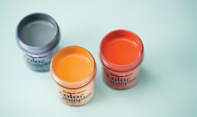 As a professional painting company, Crowder Painting has found over the years that applying paint samples before committing to the final color and sheen of paint for the job is a very important part of any house painting job. Even though it leaves me with many quarts of wrong colored paint at the end of the year, I’ve found the practice is worth it.
As a professional painting company, Crowder Painting has found over the years that applying paint samples before committing to the final color and sheen of paint for the job is a very important part of any house painting job. Even though it leaves me with many quarts of wrong colored paint at the end of the year, I’ve found the practice is worth it.
Applying a sample paint patch lets my customers evaluate the color and sheen of the finish before they spend money on gallons of paint only to realize they don’t like the color or the appearance of the sheen they’ve selected. I’ve seen customers realize that a choice that looked good in a small paint chip is totally disappointing on the wall.
I encourage paint samples for both interior and exterior applications!
There are two ways to test your color choice. Either paint a 2 foot by 2 foot section of your wall with the color you’ve chosen, or paint a sample board of about the same size. When painting on the wall, place the sample patch near the ceiling if possible. Also paint corresponding trim.
Sample boards can be made of almost any stiff material. Drywall scraps are a good choice if you are remodeling or building new. Almost every drywall project results in scraps. Poster board is a good choice and so is cardboard. Plywood works as well if you have any scraps lying around.
Advantages of Wall Sample Technique
There are advantages to painting directly on the wall. For one, if the wall is textured, it can have an impact on the appearance of the final color. Also painting directly on the wall lets you see how the paint reacts to the lighting in the room. You will have a more accurate idea of what the finished project will look like if you apply the paint directly to the wall.
If you are considering different colors choices, painting directly on the wall can make it difficult to select a color unless you paint on opposing walls. If the two colors you are considering are on the same wall, it will trick your eye.
At the same time, it’s a good idea to put your color sample on several different walls. Seeing a color in different lighting conditions can help you decide whether you need to lighten up.
One other advantage of painting directly on the wall is the fact you can live with the sample for several days. You can observe the color at different times of day. You can see what the color looks like in natural light, with lights on, with candles burning, etc. You’ll have a more accurate feel for whether the color is one you will enjoy for a long time to come.
Advantages of Sample Board Technique
Painting posterboard with the colors you are considering has several advantages. For one, you can take longer in the decision making process. A large square of paint on the wall doesn’t commit you to getting the painting job going quickly or force you to live with a large “blot” on your wall until you finally have time to move all the furniture. Instead, with sample boards, you are able to tape large painted samples on the wall and see whether you like the color or not.
also have the advantage of portability. You can carry the painted board with you as you go on shopping trips for other elements in your decor you plan on changing, such as window treatments, carpet, furniture and accent pieces.
The primary disadvantage of using sample boards is the fact that most homeowners don’t have the equipment or skills to replicate the finish that’s on the wall. The final results can vary from the expected results.
Sometimes using both wall samples and sample boards at the same time can give you the best feel for how things will look. On a sample board, you can apply your main wall color, trim color and accent colors if you wish. You can move the sample board down to floor level or furniture level to see how the color looks at different times of day, something you can’t do with a wall sample.
Meanwhile, the wall sample can serve as an anchor for comparison from a distance. It can give you an accurate feel for how the color interacts with texture.
Ultimately, the most important consideration is whether the colors you choose complement all the soft furnishings in the room, window treatments and flooring.
Final Paint Sample Tips
Always allow your samples to dry completely – at least 24 hours – before you make a decision. Paint always lightens up as it dries. The sheen also changes as the paint dries. What may appear too glossy as you apply it, may be considerably flatter after it has dried.
Always view your samples in all the lighting conditions possible in your home. Colors look different in sunlight than they do under fluorescent or incandescent light. If you like the color in all lighting conditions, you’re more likely to be happy with your color decision years from now.


